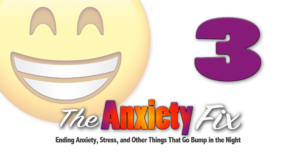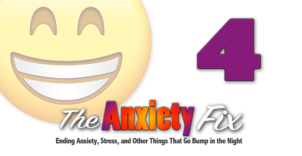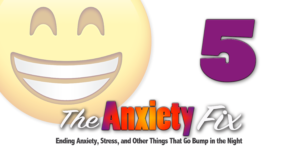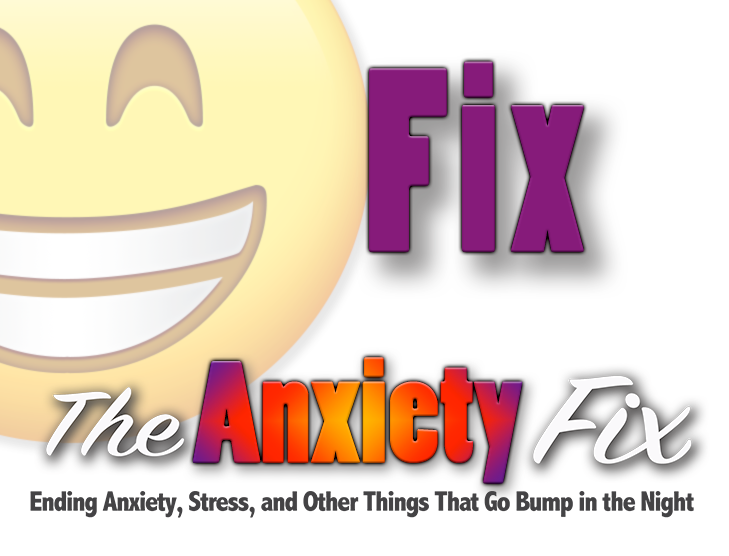
Step 4 – Finding Your Edge
Take a moment and celebrate what you have explored and experienced so far. Remember, these practices might seem simple or overly complex because your mind is going to want to discount them and return to what is familiar. Allow for the possibility that change doesn’t have to be complicated or impossible. Allow that your habits can beneficially evolve.
Habits have a sequence or a cycle, a series of small movements, decisions, and sensations that repeat. Habits follow a step-by-step progression that cycles from beginning to end and back to the beginning.
Anxiety is a habit with a cycle which can be changed.
Changing any habit can be accomplished by altering a portion of the small movements that make it up. Every modifying movement will inhibit the continuation of the familiar cycle. Find alternatives, use them, and change your habits for the better.
If you are headed to the liquor store and turn left at the corner instead of right, instead of getting a bottle of gin, you might end up at the gym. Take that turn often enough and workouts will replace alcohol as your habit. Gymnasium > Gin Nauseum. The cycle for anxiety also has a set of turns, a cycle it follows.
The sequence for the anxiety cycle is:
Baseline ➜ Ramp Up (Expansion ➜ Discomfort ➜ Unsafe ➜ Anxiety) ➜ Tipping Point ➜ Trigger ➜ Vent ➜ Baseline ↺
Or more simply:
Baseline ➜ Ramp Up ➜ Tipping Point/Trigger ➜ Vent ➜ Baseline ↺
As you can see, Expansion, Discomfort, Unsafe, and Anxiety are all part of the Ramp Up – the parts of the cycle that lead to your tipping point (props to Malcolm Gladwell for the term). In this context, the tipping point is when handling it shifts to can’t handle it, It is when your subconscious mind shifts from tolerable to intolerable.
Let’s explore each component of the cycle:
Baseline ➜
Baseline will be the start of the cycle. Remember the last time you felt anxious and then track back in time to the closest point in time when you felt close to whatever is typical for you. That is your baseline, your familiar place. It may not be perfect or even healthy, but it will feel familiar. The Baseline is often referred to as your comfort zone, but it is not always comfortable, safe, relaxing, or fun. It is whatever is typical for you in any given situation (state of being). If you are typically a hot mess, that will be your baseline. If your system has habituated to a high level of anxiety, that is your baseline.
You will have different baselines for different situations. You might have a work baseline, a relationship baseline, a social baseline, and an alone baseline. Again, your baseline has nothing to do with healthy or balance. It is whatever is typical for you in a given situation.
Ramp Up (Expansion ➜ Discomfort ➜ Unsafe ➜ Anxiety)
Your anxiety is a rollercoaster. When you are the least anxious, your systems will feel safe enough to relax and rejuvenate. You digest your food, take in the world around you, think, and emote. When that happens, you begin to accumulate energy.
Being anxious may increase your anxiety. If you worry or freak out when you start to feel anxious, you are adding energy.
As the energy builds, it expands or Ramps Up. It fills your system. You feel increasingly uncomfortable as your energy expands beyond what is typical for you. This is normal and healthy. In your physical body, homeostasis uses discomfort to monitor and adjust your physiological systems. Things like heart rate, blood oxygen levels, respiration, digestion, etc. are all dependent on knowing their range and trying to maintain it.
Your subconscious mind co-opts the intent of homeostasis to try to keep you in a familiar place. It convinces you that doing something outside of your typical zone is unsafe. The world you live in is very different than the world that existed 20,000 years ago. The sensory input then was a tiny fraction of what you experience now.
The hours a day you spend looking at your phone, in front of your computer, driving, and interacting with multitudes of different people brings a constant stream of energy into your system. Thinking and emoting generate tons of energy. It is easy to get overwhelmed by it.
The influx of stimuli can get increasingly uncomfortable. Your subconscious mind registers that increasing discomfort as unsafe. It then labels that unsafe feeling of uncomfortably-expanded-energy as Anxiety.
Depending on your pattern, the label, Anxiety, may be placed anywhere on the ramp up part of the cycle. If you are hypersensitive, it will be at the beginning. If you are desensitized, it will be closer to the end. You may live with the label constantly in place. Your ramp up may be gradual or it may feel instantaneous.
Can you identify how your anxiety builds? Does it slowly build, or does it feel like a flipped switch? What situations typically flip your anxiety switch? Which situations can you tolerate for longer periods without feeling anxious.
When and where your mind assigns the anxiety label is mainly habit but partly based on how much fear energy is currently moving in your system. The relative health of your adrenals, other hormones, and nervous system will also play a part. Fear energy would be the other factors in your life that contribute to your anxiety. Things like traffic, chaos, relationship or family strife, illness, injury, or disease. Future projections of stress also influence how you are labeling your current anxiety.
If your baseline is anxious, the ramp up will still be there. If you are extremely anxious the majority of the time, that will be your baseline and your anxiety will fluctuate above and below that level. Your ramp up will be happening most of the time.
The formation of the Anxiety label starts a cascade of events that shunts your energy to the aspects of your personality that support that label. The label creates a bias, a funneling of energy toward anxiety. You get increasingly anxious. The anxiety label shifts your physical, mental, and emotional systems into focusing on the feeling you associate with anxiety. That shift directs or shunts more and more energy toward the anxiety paradigm or archetype.
Tipping Point ➜ Trigger ➜ Vent ➜
That shunted energy builds until you reach a point that feels overwhelming, the Tipping Point. The tipping point is when it feels like you have to do something. Then, your subconscious mind starts looking for some habitual Trigger to justify dumping or Venting the energy that exceeds your baseline.
And then you vent, you do whatever you do when you feel anxious. Even actively experiencing anxiety will burn energy.
Most people do something else like overeat, drink, smoke, complain, twitch, pick a fight, or some other type of physical, mental, or emotional vent. You might over-work, over-talk, over-think, or ruminate something to death. What is your vent? If you are not sure, ask your friends and family what they see you do when you are anxious or stressed.
If your baseline is anxious, stressed, fatigued, overwhelmed, or unhealthy, you will cycle much more quickly. You won’t have much tolerance for discomfort. Look at someone, maybe yourself, that seems to constantly be in a state of stress, anxiety, unhappiness, anger, or depression and notice how little tolerance they/you have for conditions outside of their/your baseline.
For these types of people, the time from Baseline to Ramp Up to Trigger will be short and probably happen frequently. Their vents might seem continuous. Chain-smokers, nail-biters, and people who constantly talk are examples.
Now, picture someone with a ton of patience and you will find someone who is not easily triggered. They tolerate the discomfort of change. They tolerate what is going on without reaction or at least with a much more delayed reaction.
Long-term sufferers of anxiety may also be desensitized and not easily triggered. Their systems adapt and anxiety becomes part of their normal. Their vents will seem like part of their personality. They may burn their excess energy with anger, martyrdom, or depression. They may be mentally, emotionally, or physically frenetic.
Baseline ↺
Once you pass the tipping point, are triggered and start venting or dumping energy, you will do what you do for long enough to return to your Baseline, back to an energy level and state of being that feels familiar … and the cycle will begin again.
Cycles don’t have a set time or even a range. They can be a minute or a week. You can have a different cycle for every aspect of your life and every relationship you have. Cycles will overlap. Some triggers may trigger several cycles. Venting may influence multiple cycles. Baselines will be different depending on your location and situation.
The amount of energy you vent will also change depending on circumstance, adaptation, and other compounded stimuli. An erratic driver if front of you may cause frustration or rage depending on what else is happening and what other energies have compounded in your system.
As cycles become habit, you might preemptively vent energy. I wrote an article a few years ago about how I would stop and get a giant Diet Coke to help me deal with the problems I expected to await me at the office. I was defensively creating a vent because of a negative expectation. I created an Anxiety Bias. I was trying to dull myself down before I got to work so that I wouldn’t be triggered as easily.
The following video will give you a feeling of a cycle and highlight the edge or tipping point.
Finding Your Edge Description:
Step 1 – Stand and very slowly lean forward by shifting your hips forward (not by bending at the waist).
Step 2 – Feel your weight shift to the front of your feet. Feel your transition from standing upright to leaning forward.
Step 3 – Continue to lean forward until you reach a point just before it feels like you are going to fall forward.
Step 4 – Find the place where your position is critical, the tipping point where if you lean a little more, you will fall forward. This is your edge.
Step 5 – Hover at your edge (tipping point) and get to know and feel the threshold between standing and falling forward.
Step 6 – Feel how your body is working to compensate to keep you at the edge. Feel the muscles in the front of your legs and the back line of your body including your core, back, hamstrings, shoulders, and neck.
Step 7 – See how close you can get to your edge and then allow yourself to go a little too far and take a step forward.
Step 8 – Make sure you are breathing normally or a little deeper than normal. The tendency will be to hold your breath.
Step 9 – Recognize that Anxiety is a similar feeling of you compensating to try to maintain an edge.
Step 10 – Identify the difference between falling forward and deciding to fall forward.
Step 11 – Compare and contrast the set of sensations you feel just before and after you fall forward.
Why it Matters – This full-body movement highlights an obvious edge. Either you are balanced, unbalanced, or falling forward. This exercise will give you a felt sense of the tug-of-war that goes on in your subconscious mind. It will highlight how much energy you expend in each of the stages and why that edge is so fatiguing and triggering. In this exercise, if you hold the edge for long enough your mind will create tons of stories on why you should stop, your emotions will heighten to the point of overwhelm, and your physical body will signal its growing discomfort.
Everyday Usability – The same exact thing that happens in this exercise is occurring with your anxiety. It happens in every conversation, interaction, and relationship. As you increase your subtle awareness, you will recognize your internal struggles, be able to tolerate the discomfort, and then take the most beneficial actions. You might also be able to rebalance yourself before you get anywhere close to the edge.
Progression – After you feel your edge in this standing meditation, begin to feel for it in all other areas of your life. You will be amazed by how many edges you have and what you do to prevent, exist in, or accelerate the tipping points. Stress and tension are edges with tipping points. You can also begin to identify what your triggers and vents are. What sets you off and what do you do to burn off your excess energy?
Step Four – Wrap Up
You don’t experience anxiety because of money, job, weight, stress, spouse, or family. You experience anxiety because you haven’t learned how to tolerate your current energy levels or your current amount of vitality.
Anxiety is an Abundance of Energy Without a Defined Purpose.
Find an aspect of yourself that you admire or some aspect of your life where you excel and remember the learning curve. Remember the failures and discomfort that preceded your success or mastery. You tolerated the discomfort because of your drive to succeed. Your energy had an outlet (the goal), it didn’t build up and become anxiety.
The discomfort you felt was a part of the success cycle. The discomfort was specific to your goal. Anxiety usually happens when your general energy expands past the point of tolerance without a strong driving force or focal point (such as a specific goal or outlet). Changing your anxiety habit will require the tenacity you showed in your other successes.
Anxiety, stress, and tension are what if feels like when you maintain an edge.
The simple sequence for the anxiety cycle is:
Baseline ➜ Ramp Up ➜ Tipping Point/Trigger ➜ Vent ➜ Baseline ↺
In the next video, you will explore ways to disrupt the cycle of anxiety and make a different choice. When you make different choices, you will be able to stop anxiety before it starts.
If you get stuck or have any questions, please feel free to email us.
And remember, anytime you are actively anxious, stressed, or overwhelmed, do one of the movements on the video page.














